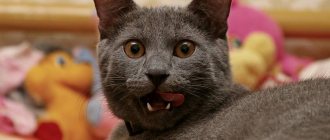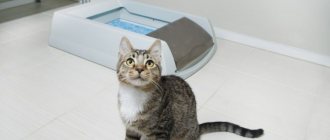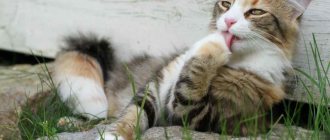Why cats rub against their legs: 5 reasons
The cat owner believes that the animal can be taught something and required to perform certain actions. And the pet believes that it is able to train the owner so that he carries out exactly his orders. However, only the owner can formulate his judgment about the pet’s behavior.
According to the owner, the cat rubs against its legs for the following reasons:
- Caress the owner and receive more tenderness in return.
- Mark a person's feet or clothing as part of their territory to let other cats know: This is my property. The person does not smell the secretion of the cat's sebaceous glands, so he does not mind.
- Remind the owner that it is time to replenish the food bowl. Or remind the housewife who is cutting up meat or fish that it would be nice to share with her pet.
- Assure the leader of the pride of your loyalty.
- Kitty went on a spree, but so far it has not been possible to attract a person of the opposite sex. Maybe the owner will find a way to ease the suffering at least a little.
The highest concentration of sebaceous glands is located on the muzzle and at the root of the tail. It is with these parts of the body that the cat prefers to come into contact with objects that need to be marked as its own. When a cat is stroked on the face, it purrs with satisfaction. Perhaps because in this way the kitty will be able to mark the palms of the mistress.
Be sure to read:
A cat licks a person’s hands and face: 5 reasons, what to do, why the cat constantly licks itself
Unfortunately, the aggressive external environment: rain, sun, gasoline smells, smog, inactivate the marks left by the cat on the owner’s clothes.
Therefore, when a person comes home from work, the cat seeks to restore its sovereignty and rubs its muzzle against its legs. At the same time, they manage to bring the owner into a complacent state and beg for something tasty.
Cat behavior
There are two main opinions on this matter. First: this is how purrs leave their scent on our feet, and simply mark their territory. As proof, supporters of this opinion cite a standard situation: the owner came home from work in the evening and must be re-initiated into the aromas of the house where the cat lives. Second: this is how animals communicate and attract attention to themselves in order to get something they want. For example, a cat's affection becomes noticeably more persistent if the owner has a box of food or something tasty in his hands. In this case, the pet can rub not only against the owner’s legs, but also against the legs of a chair or the corner of a wall.
scent trail
One way or another, every cat periodically rubs against something or someone. This means there is something species-wide in this. Domestic cats rub against their owners with their muzzle or front part of the body. The mother cat gently licks the babies and touches them with her nose. Suggests that the smell theory still has confirmation. After all, it is in the area of the cheeks and neck of cats that the zone for producing pheromones is located.
Why and why cats prefer to leave their scent marks on their owner’s clothes or furniture depends on the situation. Being safe in its own territory, the cat rubs its muzzle against its legs, thereby indicating its comfort zone, and possibly expressing love and gratitude. If a pet finds itself in a new territory or encounters a stranger in its own, completely different glands come into play: those closer to the tail are paranal.
Smells are of great importance in the animal world. Some are needed to create sexual pairs, others to scare away enemies, and others for self-defense. So, in the arsenal of animals you need to highlight at least these:
- Epagons are substances that help establish bonds of love between individuals, even for a short period of time. The smells of maternal care are born on the muzzle and neck, and those that attract a partner are born on the back of the body;
- Odmihnions are guiding smells. With their help, the route is marked. Most often they are produced by glands on the paws;
- Toribones are chemical indicators of fear and anxiety. Even where the enemy is not visible or heard, animals are able to warn of his approach with the help of scents. Moreover, sometimes only representatives of the same species can recognize them;
- Gonophions and gamophions are substances of sexual life. They determine, for example, the sexual maturity of an individual;
- With the help of lychneumons, some animals mark attractive objects: tasty, for example;
- Aminones are foul-smelling defensive liquids that are very difficult to remove from surfaces.
Something else interesting: Why do cats trample us with their paws?
And this is far from a complete alphabet of pheromones, with the help of which animals communicate without words over vast distances or in close contact. So, if a cat rubs against people and objects, you should take a closer look at its behavior and try to understand why it does this.
Why do cats rub against people and objects?
Why cats rub against people is mentioned above. And they rub against objects to stake out territory so that other cats don’t encroach on it. But, this is if the cat is healthy.
If your pet scratches furiously on the raised corners, he may be itching due to the following reasons:
- ectoparasites: lice eaters or fleas;
- subcutaneous mites - Notoedrus and Demodex;
- fungi: Microsporia, Trichophytosis, Malassezia;
- allergic reactions.
In such cases, skin lesions appear on the cat’s skin: scratches, skin rashes, crusts, areas of baldness. This situation requires independent treatment against ectoparasites. If the problem cannot be solved on your own, contact a veterinarian.
How to stop a cat from rubbing against your legs
Pleasant moments
If pets rub against something, then, as a rule, this does not cause negativity in a person. But there are exceptions.
There are people who don't like this behavior. And they are not ready to put up with violation of personal space. If the owner does not want to let the cat too close into his life, then it is worth weaning him from this habit.
- It's worth taking a step back whenever the cat tries to do this.
- The cat should not be rewarded for this process. Pet or give a treat.
The cat rubs against its legs: should we wean it or encourage it?
If the pet is healthy and has a nice coat, then confusion underfoot should be treated favorably, except for the following cases:
- Begging . When your pet has received his allotted portion of food and asks for more, you should not follow his lead. It is necessary to distribute food distribution so that the cat eats less during the day and more in the evening. To ensure a good, healthy sleep at night. If the cat receives ready-made food, but begs for pieces of meat or fish when cutting it, it is better not to give it. It has been observed that when fed premium or higher prepared foods, cats get sick less and live longer.
- The sterilized cat began to rub herself. An unspayed female may have bred nearby. In order not to provoke sexual behavior, you need to leave.
- The pet is trying to pity the owner and allow him into the child’s bedroom or room, where he is not allowed to enter. What to do? Ignore. The cat will understand that his attempts are not being followed and will stop bothering him.
Be sure to read:
Why cats fight: reasons, what to do when a cat fights with a cat, how the owner should behave
A cat that gets under your feet should not be scolded or rudely pushed away, otherwise the pet will experience stress, under the influence of which its behavior will deteriorate.
If friction against the legs of an uncastrated animal is associated with sexual behavior, you can give drugs with phytoestrogens: Kot Bayun, Stop Stress, Vetspokoin. Hormonal contraceptives should be used only with the permission of a veterinarian.
The cat rubs against its legs: unpleasant consequences
The cat tests others' resistance to harassment and the owner should decide whether to indulge the pet in everything or not to encourage getting in the way. If there is a child in the house, he may be allergic to wool. The risk of infecting children with worms from cats is minimal, but not zero.
Having felt like the owner of the apartment, the cat can climb into the bed and, from an excess of feelings, mark it, but not with pheromones of the sebaceous glands, but with urine.
You should let your pet know what he can and cannot do. He will understand and limit himself to what is not prohibited. Household members should develop tactics for handling their pet. If one family member forbids him something, and the other allows him, the pet’s behavior will deteriorate. And the owners will be distressed by the appearance of urine and feces in inappropriate places.
Translated from cat
Regardless of why a cat rubs against its owner and his furniture, it is perceived as either “good” or “bad.”
Wean or encourage?
Most people are still affectionate. This behavior does not need to be specifically encouraged - your pet will happily repeat her simple ritual over and over again. But there are still cat breeders who prefer to contemplate the cat rather than let it into their personal space.
Something else interesting: How to properly litter train a domestic cat
To stop your pet from rubbing against your legs, it is enough to step back a few steps each time he does this, and then take his original place. And never encourage unwanted behavior either with words, or with thrown pieces of food, or with touches.
Speak like a cat
It is not known what cats think of humans, whether they accept them as “service personnel” or idolize them. And we may never know. But any owner can learn to speak cat language and correctly convey their requirements, emotions and commands to their pet.
Since childhood, kittens carefully observe people and learn to distinguish emotions by facial expression, posture and tone of voice. Why don't people do the same? Here are some basics of cat language:
- Sight. Even a child can recognize the expression of a cat's face in combination with movable ears. By the way, children are especially sensitive to this - they are very good at distinguishing when a cat is angry or asks for something. And cats learned to look into the eyes after domestication; they do not use such “begging” looks among themselves;
- Hissing is a strict and unambiguous cat “no” or a danger signal. Hissing is never good-natured.
- Actions with paws: touching, pulling, trampling, kneading - all this is an expression of recognition, favor, request;
- Sounds. A scientist named Dupont du Nemard discovered that cats make many sounds: a, o, y, m, n, g, x, f, v, r. Sometimes they make up quite legible words and phrases (remember several sensational videos about talking cats). The alphabet is quite simple, of course, but how many “meows” and “mrr-r-lr-lr” loving cat owners can recognize!
- Poses. An open, trusting belly, an emotional, moving tail, and a curved or arched back can tell about the pet’s mood, well-being and intentions.
So, if a cat rubs against the owner’s legs, this is at least worth paying attention to. Whether it’s a request or a complaint, a gentle greeting from “one of our own” or an expression of negativity towards a “stranger” - to understand a cat, you need to look closely, listen and smell. After all, we are responsible for those we have tamed, and we are obliged to understand and fulfill their desires.











